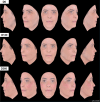Clinical Evaluation of an Innovative CaHA Bio-Stimulator in Facial Rejuvenation: 1 Year Follow-Up
- PMID: 40344488
- PMCID: PMC12063517
- DOI: 10.1111/jocd.70210
Clinical Evaluation of an Innovative CaHA Bio-Stimulator in Facial Rejuvenation: 1 Year Follow-Up
Abstract
Background: Skin aging is characterized by wrinkles, loss of elasticity, laxity, and rough texture, resulting from degenerative changes in the skin's layers. Effective treatments targeting skin structure are increasingly sought after in aesthetic medicine.
Aims: This study aimed to evaluate the safety, efficacy, and long-term outcomes of STIIM, a novel calcium hydroxylapatite (CaHA)-based bio-stimulator, in facial rejuvenation.
Patients/methods: Thirty-two patients aged 35-59 received diluted CaHA injections. Outcomes were assessed through patient satisfaction surveys and objective measurements, including ultrasound evaluation of dermal thickness. Follow-ups were conducted at 120 and 360 days post-procedure. Safety was evaluated by monitoring adverse events.
Results: At 120 days post-treatment, 85% of patients reported visible aesthetic improvements, and ultrasound assessments in a subset of patients demonstrated a significant 51% increase in dermal thickness, indicating improved skin structure. At 360 days, 75% of the patients continued to report aesthetic benefits, confirming the durability of the results. The treatment was well-tolerated, with no serious adverse events reported throughout the study period.
Conclusions: This novel CaHA-based bio-stimulator demonstrates a safe and effective profile for facial rejuvenation, providing significant aesthetic and structural improvements with long-lasting results. It offers a promising option for addressing the challenges of skin aging.
Keywords: calcium hydroxilapatite; patient satisfaction; skin laxity.
© 2025 The Author(s). Journal of Cosmetic Dermatology published by Wiley Periodicals LLC.
Conflict of interest statement
M.K., D.M., and C.L. provide lectures and training on behalf of Ilikia Brasil, the distributor of the product used in this study. R.V. serves as a scientific consultant for Ilikia Brasil. G.P. previously delivered lectures for Ilikia Brasil but currently has no affiliation with the company. E.D., who was responsible for the ultrasound analyses in the study, declares no conflicts of interest.
Figures







Similar articles
-
Microfocused Ultrasound With Visualization (MFU-V) and Hyperdilute Calcium Hydroxylapatite (CaHA-CMC) of the Lower Face and Submentum to Treat Skin Laxity: A Pilot Study Demonstrating Superiority of MFU-V First Followed by Hyperdilute CaHA-CMC.Aesthet Surg J. 2025 Feb 18;45(3):305-312. doi: 10.1093/asj/sjae226. Aesthet Surg J. 2025. PMID: 39511699 Clinical Trial.
-
Prospective Clinical Trial Evaluating the Long-Term Safety and Efficacy of Calcium Hydroxylapatite for Chest Rejuvenation.J Drugs Dermatol. 2021 May 1;20(5):534-537. doi: 10.36849/JDD.5680. J Drugs Dermatol. 2021. PMID: 33938688 Clinical Trial.
-
Hyperdiluted Calcium Hydroxylapatite 1: 2 for Mid and Lower Facial Skin Rejuvenation: Efficacy and Safety.Dermatol Surg. 2020 Dec;46(12):e112-e117. doi: 10.1097/DSS.0000000000002375. Dermatol Surg. 2020. PMID: 32205749
-
Aesthetic Efficacy and Safety of Combined Microfocused Ultrasound With Visualization and Calcium Hydroxylapatite Treatment: A Systematic Review of Human Evidence.Aesthet Surg J. 2025 May 15;45(6):638-642. doi: 10.1093/asj/sjae239. Aesthet Surg J. 2025. PMID: 39883075 Free PMC article.
-
Labia Majora Rejuvenation With Hybrid Filler: A Narrative Review of the Literature and Report of Two Cases.J Cosmet Dermatol. 2025 Mar;24(3):e70074. doi: 10.1111/jocd.70074. J Cosmet Dermatol. 2025. PMID: 40013509 Free PMC article. Review.
References
MeSH terms
Substances
LinkOut - more resources
Full Text Sources
Medical

